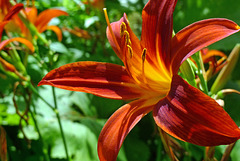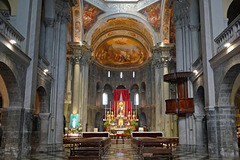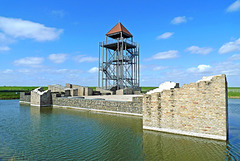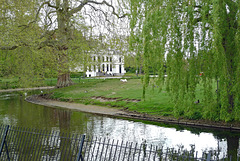Jaap van 't Veen's photos
Italy - Pavia Cathedral
| |
|
|
|
The history of the Cattedrale di Santo Stefano e Santa Maria Assunta dates back to 1488, when its construction began on the site of two pre-existing Romanesque, "twin" cathedrals. From this date onwards many people contributed to the design of the cathedral, including Leonardo Da Vinci who visited Pavia during the early stages of the cathedral's construction. The church was not fully completed until the 1930s, more than 400 years after the first stone was laid.
The plan of the Pavia Cathedral is a Greek cross, with three naves flanked by semi-circular chapels. The central nave is twice as wide as those on the side; it is about 30 metres high and divided by two galleries. The dome has an octagonal plan and is the fourth largest in Italy with a height of 97 metres and a span of 34 metres.
The Cathedral of Pavia is the most important Renaissance building of the city, recognizable by its impressive octagonal masonry dome.
Nederland - Kasteel Geldrop, Bloemenhof
| |
|
|
|
Kasteel Geldrop (Geldrop Castle) - dating back to the year of 1350 - is located right in the center of Geldrop.
The former vegetable garden and orchard was laid out around 1870 by Hubertus Paulus Hoevenaar jr., operator of sugar factories in the East Indies. In 2002, this vegetable garden was transformed into the Bloemenhof , a stunning garden, which is full of blooming flowers in summer, when the borders are filled with exuberant plant combinations, such as old shrub roses, grasses and cut flowers.
Italy - Como, Basilica di San Fedele
| |
|
|
|
The Basilica di San Fedele - the ancient cathedral of Como - was probably built in 1120 on the ruins of a previous building. The construction was finished years later. Along the centuries the original Romanesque setup of the building was largely modified. In the 17th century the main nave changed into a barrel vault ceiling and side apsides were modified in the 16th century when some arcs were closed and replaced with paintings and stuccos. In 1805 the octagonal lantern was moved up. Between 1807 and 1808 the side chapels were built. Also, the church was restored in the beginning of the 21st century, especially the façade and the tower bell.
I have seen many churches all over the world and consider the interior of the San Fedele as one of the most beautiful. I visited the church in 'corona time', because a mouth mask was still obligatory - which I did not have with me - it unfortunately remained a very short visit with hardly any time to take pictures.
Nederland - Kasteel Geldrop
| |
|
|
|
Kasteel Geldrop (Geldrop Castle) - dating back to the year of 1350 - is located right in the center of Geldrop. A beautiful English garden - created at the end of the 10th century - with some exotic trees surrounds the castle. Next to the castle lies the Bloemenhof , a stunning flower garden. The complex is delimited by a monumental wall.
The first owners of Kasteel Geldrop were “Jan and Philip van Geldrop”, who probably built it in 1350. The following century the castle remained in the Van Geldrop family. The construction of the present day castle started in 1616, when “Amandus I van Horne” had the middle facade built.
In 1768 the heirs of “Van Horne” sold the manor to “Adriaan van Sprangh”. The new Lord of Geldrop had the castle and living-tower renovated. In 1798 feudal rights ended with the French Revolution. The title of Lord of Geldrop became an empty one.
In the 19th century the castle came into the hands of the “Hoevenaar” family. Under the ownership of “Sara Hoevenaar”, in 1840 the medieval living tower was demolished. During “Hubertus Hoevenaar” the castle got its present look. His daughter “Arnaudina” married baron “Van Tuyll van Serooskerken”. They lived in the castle permanently from 1912.
Nowadays Kasteel Geldrop is used for weddings, concerts and exhibitions. The latter have limited openning hours. Since 30 December 1996 the Stichting Landgoed Kasteel Geldrop (a foundation) owns the castle, the outbuildings and the more than 11 hectares of parkland. Before that, the estate had been in the possession of the municipality of Geldrop (then not yet merged with Mierlo) for 22 years.
Nederland - Sint Agatha, kloostertuin
| |
|
|
|
The Kruisherenklooster (Monastery of the Crosiers, formally known as the Canons Regular of the Order of the Holy Cross) in Sint Agatha is dating back to 1315. In that year there was already a chapel dedicated to St. Agatha. Around 1371, some monks came to live near the chapel to attend it. The monastery of the Order of the Holy Cross arose from this little chapel. The monastery is still in use and is therefore the oldest monastery in the Netherlands still inhabited by clergy.
From the 18th century onwards, the monastic garden was laid out. It is enclosed by a wall. It contains orchards, vegetable gardens and fish ponds, while until 1985 farm buildings were also located within the garden. A number of Crosiers practised gardening. The garden is also a reminder of religious matters. The boxwood hedges are cut in shapes like a cross on a globe, a snake, a ship and so on.
The garden has an area of 2.5 ha and offers, apart from a lot of nice and colourful flowers, also a number of monumental trees, such as a 150-year-old tulip tree, a red and a green beech and an old oak. The monks were self-sufficient and for centuries lived largely off the proceeds of the land: a vegetable garden, fruit trees, fish ponds, chicken coops and beehives.
Nederland - Cuijk, Sint-Martinuskerk
| |
|
|
|
The Sint-Martinuskerk is a Neo-Gothic cross basilica with two towers. The church was designed by architect Caspar Franssen and built in the period 1911-1913.
The paintings in the interior were designed by Hans Mengelberg and executed by Johannes Cornelis Wilbrink. The retable of the beautiful Flemish high altar - Retabel van Cuijk - was made by Hendrik van der Geld for a church in Duisburg, but eventually ended up in Cuijk. The side altars and piëta are also by Van der Geld.
The church has an organ dating back to the mid 17th century.
In 1945, the church was heavily damaged by acts of war committed by the retreating German army on the other side of the river Maas. The damage could be repaired (interior and exterior). In 2009, a major restoration of the church began and was completed in 2011.
Nederland - Wanroy, Hamse Molen
| |
|
|
|
The Hamse Molen , popularly known as De Ster , is a grinding post mill. The mill was built between 1810 and 1811. After a restoration in 1950, the mill was neglected and collapsed in 1974. But it was completely rebuilt in 1977.
The mill is quite unique for the Netherlands, because of the fact that this is the only closed, three-storey post mill in the country.
The official name Hamse Molen of the mill comes from the Hamse Veld , the original name of the grounds on which the mill is located. The windmill is operated by volunteers and can be visited during (limited) opening hours.
Nederland - Kasteel Helmond
| |
|
|
|
The construction of Kasteel Helmond (Castle Helmond) started around 1325. The castle was the replacement of an older castle, known as “ ‘t Oude Huys”, which was located hundreds of meters west. Kasteel Helmond was owned by several noble families, like the Berlaer, Cortenbach and Arberg family.In the year of 1781 the castle would fall into the hands of Frederik Carel Wesselman.
The construction of the new castle took a long time. It was not until the end of the 17th century that it had roughly reached its present form. Kasteel Helmond , which originally served as a military defence fortress, came through the centuries relatively unscathed. However, there was a short siege during the Eighty Years' War by Prince Maurits van Oranje.
In 1921, the castle was sold to the municipality of Helmond by the last Lady of the family Westerman under the stipulation that the castle would be used for the municipal administration or other public use. The Lady’s wishes were respected and the castle served as a town hall from 1923 until the 1970s. Very little remains of the original interior of the castle as the structure had continually been updated throughout history. A few stucco ceilings and several fireplaces are the only original features.
Kasteel Helmond - the largest moated castle of the Netherlands - nowadays houses a museum, exhibiting the history of the castle and its owners. It also still hosts weddings.
Nederland - Kasteel Wijchen
| |
|
|
|
Kasteel Wijchen (Wijchen Castle) is a moated - almost square - castle with a small courtyard. It is not exactly known when the castle was built; due to architectural details probably somewhere in the 14th or early 15th century. The castle was first mentioned in a written source in 1392. From the 14th to the 17th centuries, it served as a defensive tower and castle.
During these times, it was occupied by a number of families, was severely damaged, ransacked and rebuilt on numerous occasions. In 1609, Kasteel Wijchen came into the hands of Emilia van Nassau, a daughter of Willem van Oranje, Father of the (Dutch) Nation. The money for the purchase was raised partly from the sale of a valuable pearl necklace. This was necessary because her marriage to Don Emauel of Portugal was not blessed by the Dutch stadtholder. They rebuilt the castle to its present Renaissance appearance.
After the death of Emilia in 1629 the castle was sold by her children. In the 17th and 18th century Kasteel Wijchen had several owners. In that period the castle fell into disrepair when it was used as a summer residence by Belgian owners. In 1903 the castle was sold at a public auction. Its new owner became Lady AW. van Andringa de Kempenaer. She renovated the castle only for it to be struck by a devastating fire in December 1906. Luckily the castle was rebuilt two years later.
In 1932 Kasteel Wijchen was bought by the town of Wijchen and became a town hall. At present part of the castle still serves as a town hall. Other parts nowadays are used as a museum.
Nederland - Sint Agatha, Jan van Cuijk
| |
|
|
|
The “Jan van Cuijk” is a round brick so called beltmolen (belt = a man made mound). The windmill was built in 1860 as a grain and bark mill commissioned by Vincent van Riet. The white painted corn mill is officially located in the hamlet of Sint Agatha. Originally the mill was named “Hagelkruische molen” and later named after lord Jan van Cuijk, friend of King Edward I of England and of the Duke of Brabant.
At the outbreak of the World War II, the mill was damaged and during the liberation in 1944 it was hit by several shells. In 1942, the belt was excavated and replaced by a warehouse. At the end of the 1950s, permission for demolition was granted, but it never came to that. However, an electric grinding shop was started in the mill. In 1971, the “Jan van Cuijk” was sold to the municipality.
The “Jan van Cuijk” is regularly operated by volunteer millers on Saturdays.
The mill has the status of a Dutch national monument.
Nederland - Limmen, Bloemendagen
| |
|
|
|
At the end of April, the annual Bloemendagen (Flower Days) are organised in the village of Limmen. Important elements are the mosaics of hyacinths which are displayed all over the village. These flowery works of art are made by groups of residents/neighbours/friends/family.
Nederland - Bergen, Ruïnekerk
| |
|
|
|
The Ruïnekerk (Ruined Church) is dating back to the second quarter of the 15th century and was built on the site of a smaller pilgrimage chapel, which was built after the so called ’Miracle of Bergen’ in 1422.
At time of the construction the church was the largest in the province of North-Holland. Originally it was a Gothic church, dedicated to Peter and Paul. In 1574, during the Eighty Years’ War against Spain, the church was looted and burned down by Dutch Protestants troops De Geuzen . The tower was lost completely, but the rulers of Bergen prevented the eventual destruction of the other remains, parts of the outer walls of the nave and the walls of the choir with its flanking chapels. The choir was rebuilt in 1594-1597 to serve as a Protestant church.
Between 1955 and 1961 the church was restored and became a new wooden porch. The date 1958 is inscribed on the church facade to commemorate the restoration. In 1970, a 26-bell carillon was installed.
Nowadays the church is still used for weekly services, but also for weddings, funerals and other cultural events. The Ruïnekerk - a national monument - is the landmark of Bergen, located right in the heart of the village.
Nederland – Sint Maarten, Kasteel 't Huys te Nuwen…
| |
|
|
|
Kasteel ‘t Huys te Nuwendore (Castle 't Huys in Nuwendore) was a fortress built by Count Floris V to keep the rebellious West Frisians in check. The castle was built in the 13th century, at the same time as some other castles, among them the Kasteel Radboud in Medemblik. Originally the castle consisted of a residential tower measuring 11 by 11 metres, a main castle measuring 32 by 32 metres and an outer castle.
Kasteel ‘t Huys te Nuwendore was destroyed at the end of the 14th century, probably as a result of a dike breach. The foundations were preserved by the Rijksdienst voor de Monumentenzorg (National Monument Care) in 1960.
Nowadays a watchtower stands on the site of the 13th-century tower. The grounds can now be visited and the tower climbed, which allows a wonderful view of the surrounding landscape.
Nederland - Egmond aan den Hoef, Wimmenumer Molen
| |
|
|
|
Wimmenumer Molen (Wimmenumer Mill) - a polder mill that drained the Wmmenumer polder - was built in 1774, after its predecessor had been destroyed by a storm a year earlier. The polder was drained from around the middle of the 16th century; before or at the same time as two nearby lakes were drained. The windmill remained in operation until 1951, when it was taken over by an electric pumping station located next to the windmill.
In 1953, the mill was rented to a private person, who bought it two years later from the water board. For the first few years, it was only a summer residence, but in 1967, the mill was restored and has an auxiliary function. Since then, the mill has been in operation regularly again.
Wimmenumer Molen is named after the hamlet Wimmenum, which is situated north of Egmond aan den Hoef.
Nederland: Velsen-Zuid, Buitenplaats Beeckestijn
| |
|
|
|
The history of Buitenplaats Beeckestijn (summer residence Beeckestijn) goes back to the 15th century. Beeckestijn used to be a country house for rich merchants from Amsterdam. In 1742, Jan Jacob Boreel bought Beeckestijn. Of all the residents, he left his mark on the appearance of the estate the most. Since early 2011, Natuurmonumenten has been the manager of the gardens and the park forest.
The publicly accessible gardens of Beeckestijn are unique in the Netherlands, because it is the only location where one can simultaneously view two historically different styles. Just behind the manor a geometrically conceived part in the style of the French Baroque and adjacent a more natural English landscape park.
Beeckestijn also has so-called utility gardens, such as a vegetable garden, orchard and herb garden. One of these gardens has a serpentine wall on two sides. The Netherlands only has eight of these walls left, two of which are at Beeckestijn. The winding shape retains heat from the sun and ensures that espalier fruit such as peaches, apricots and other exotic fruits can grow here.
Garden and park forest are managed by ‘Natuurmonumenten’ - a Dutch society for preservation of nature monuments in the Netherlands.
Nederland: Velsen-Zuid, Buitenplaat Beeckestijn
| |
|
|
|
Buitenplaats Beeckestijn (summer residence Beeckestijn) is an 18th century estate and one of the few entirely intact large country houses, which was created as summer residences for wealthy Amsterdam merchants and regents on the edge of the dunes in Kennemerland. The present building was created from a 17th century manor and had several alterations and extensions.
The most extensive expansion took place between 1716 and 1721, commissioned by Jan Trip jr. and Petronella van Hoorn. Among other things the 17th century façade was replaced by a Louis-XIV façade, with chequered pilasters and a richly decorated entrance.
For more than two centuries Beeckestijn remained in the ownership of the Boreel family, until it was acquired by the municipality of Velsen in 1952. During WW II the house was seriously damaged. It became uninhabitable and key interior elements disappeared; the restoration was completed in 1969.
The manor is now owned and managed by ‘Vereniging Hendrick de Keyser’ - an association for the preservation of historic houses in the Netherlands. Since June 2019 Buitenplaats Beeckestijn is a museum, where one can experience the atmosphere in which the rich merchants of Amsterdam used to live.
Nederland: Velsen-Zuid, Buitenplaats Velserbeek
| |
|
|
|
Velserbeek is one of the many so called buitenplaatsen (summer residences) west of the city of Haarlem along the inner dunes. Wealthy merchants from Amsterdam built their mansionsin the 16th and 17th centuries.
Buitenplaats Velserbeek is dating back to jaar 1544. Originally it was a farmhouse, owned by the regent-family Ramp who lived in nearby Overveen and held governmental positions in Haarlem. In 1639, the homestead was sold to the wealthy Amsterdam merchant Jerimias van Keulen. Van Keulen was very wealthy and had a family of 15 children. He had the homestead extended into a country estate with the present mansion and ornamental gardens. The park was laid out in the French.
In the years that followed, Velserbeek had several different owners. From 1781 it was owned by the members of the Goll van Franckenstein family. Until 1832 Velserbeek remained in the possession of this family. The heirs sold the Velserbeek country house to the Van Tuyll van Serooskerken family. Baron Ernst van Tuyll almost immediately commissioned changes to the garden layout. The most important change is the creation of a deer park in front of the mansion, which nowadays still exists.
In 1919 Velserbeek was sold to two entrepreneurs, who want to convert the main building into a factory. Eventually, the municipality of Velsen buys the estate: the most beautiful part became a public park, while another part is destined for the construction of villas.
Since 1995, Buitenplaats Velserbeek has been owned by a law firm, which has restored the house.
Nederland - Vijfhuizen, Nationaal Monument MH17
| |
|
|
|
On the 17th of July 2014, the world was shocked by the devastating report that flight MH17, an international passenger flight from Amsterdam Schiphol Airport on its way to Kuala Lumpur, was shot down as it flew over Eastern Ukraine. All innocent 15 crew members and 283 passengers died.
The Nationaal Monument MH17 honours the victims of this disaster and keep the memory of them alive, as a symbol of hope, faith and reflection. In the park-like environment you will find 298 trees. Lime trees, ironwood, ash, hawthorns, pines and ornament.
The monument consists of a tree ribbon and a memorial. The green ribbon rises from the landscape. On this 298 trees were planted: one for every victim. With each tree you will find the name, age and nationality of the victim. For passengers who travelled together, the same tree species were planted. These ones stand side by side. Ten different tree species have been planted for the passengers. The chosen species also emphasise the diversity of the deceased passengers. For the crew of flight MH17 a separate kind has been chosen: lime trees. These are in front, on the edge of the amphitheater.
The heart of the tree ribbon is an amphitheater. Here you will find the memorial. This consists of a wall of rusted corten steel. A stainless steel sculpture has been placed for this purpose: the “iris”. The pupil of the iris is a high-gloss polished surface. Here are the names of the 298 victims engraved. The rust and the transience of the steel symbolize the grief, the iris the memory and the comfort. Seen from above the memorial has the shape of an eye that looks into the sky; a connection between victims and surviving relatives.
War seems far away in the Netherlands. Nothing is less true. The knockdown of MH17 is considered an act of war in a conflict that leads back to the Cold War. Now as a violent offense from a hybrid war peace seems to be a plaything of power politics and arbitrariness. With unforgettable suffering as a result.
The National Monument MH17 is a recognisable landscape element. The shape and design of the tree ribbon tattoos the surrounding land. A sculpture of 298 trees that demands permanent attention for peace and safety.
Jump to top
- ipernity © 2007-2024
- Help & Contact
|
Club news
|
About ipernity
|
History |
ipernity Club & Prices |
Guide of good conduct
Donate | Group guidelines | Privacy policy | Terms of use | Statutes | In memoria -
Facebook
Twitter


















